Regular Message
A text message is an automated message sent by the chatbot to a user within the WhatsApp platform. This message can guide the user through a series of options or interactions. The text message can include plain text, emojis, and interactive elements like a list that allows users to make selections and receive tailored responses. These messages are designed to facilitate efficient and engaging communication between the user and the chatbot.
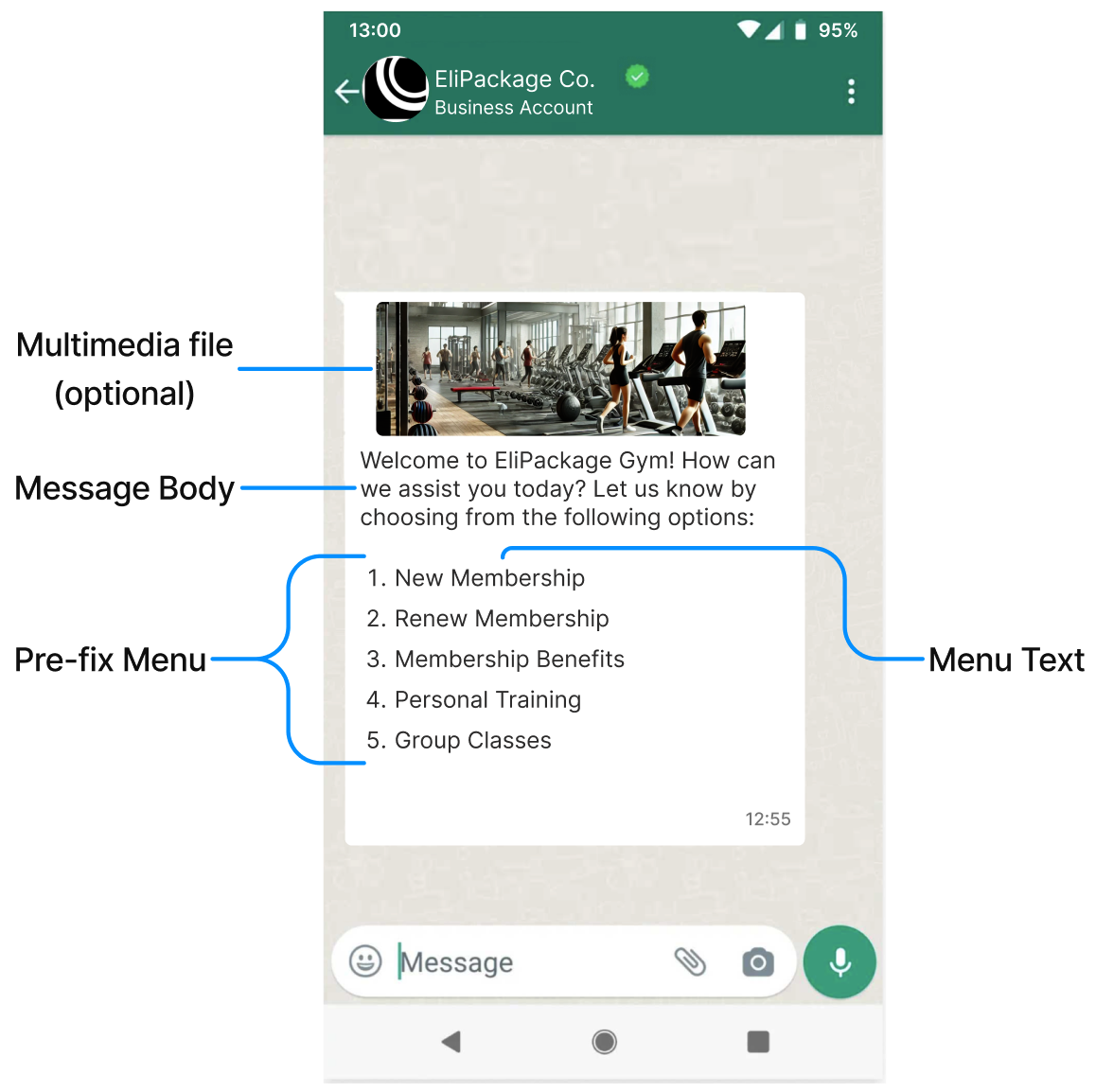
Here are the steps to set up a regular message for the Welcome Message:
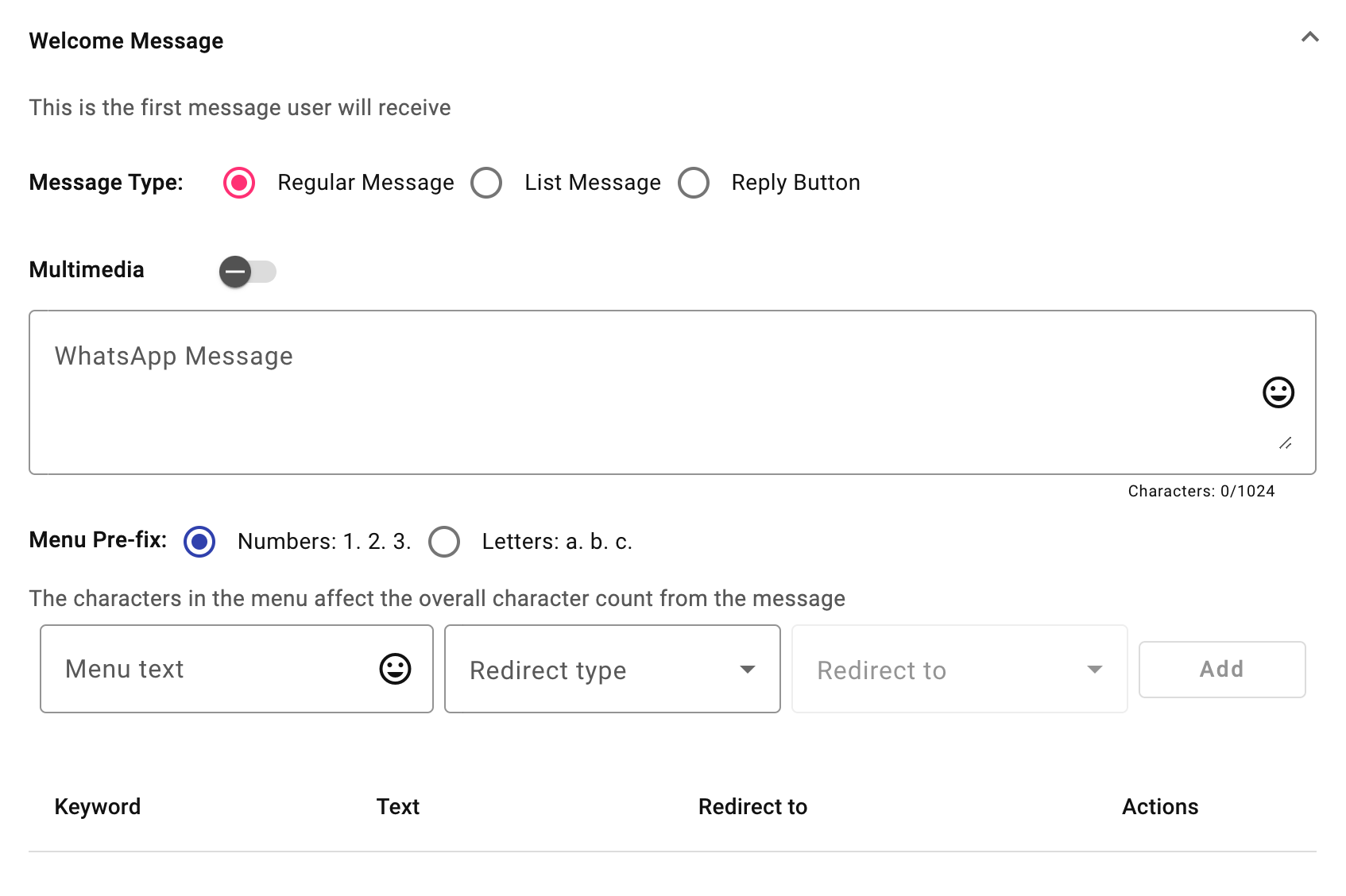
- Select the Regular Message interactive message option.
- Define the welcome message to initiate the conversation with the chatbot.
- Setting the available options that users can pick from.
- Configure the selection menu through the "Menu Pre-fix" option.
- Specify where the user will be redirected once they select the desired option from the menu.
Define Welcome Message
Enter the greeting message aligned to the chosen channel type, each with its own characteristics; SMS using the standard 160-character cap, WhatsApp with 1024 including emoji capability that you select from the smiley face on the right end of the message box, and RCS with 1024 characters. The Welcome Message supports Markdown syntax, allowing you to format the text for a more engaging and clear presentation. You can use basic Markdown options such as bold, italics, strikethrough, and monospace to enhance the readability and impact of the welcome message.
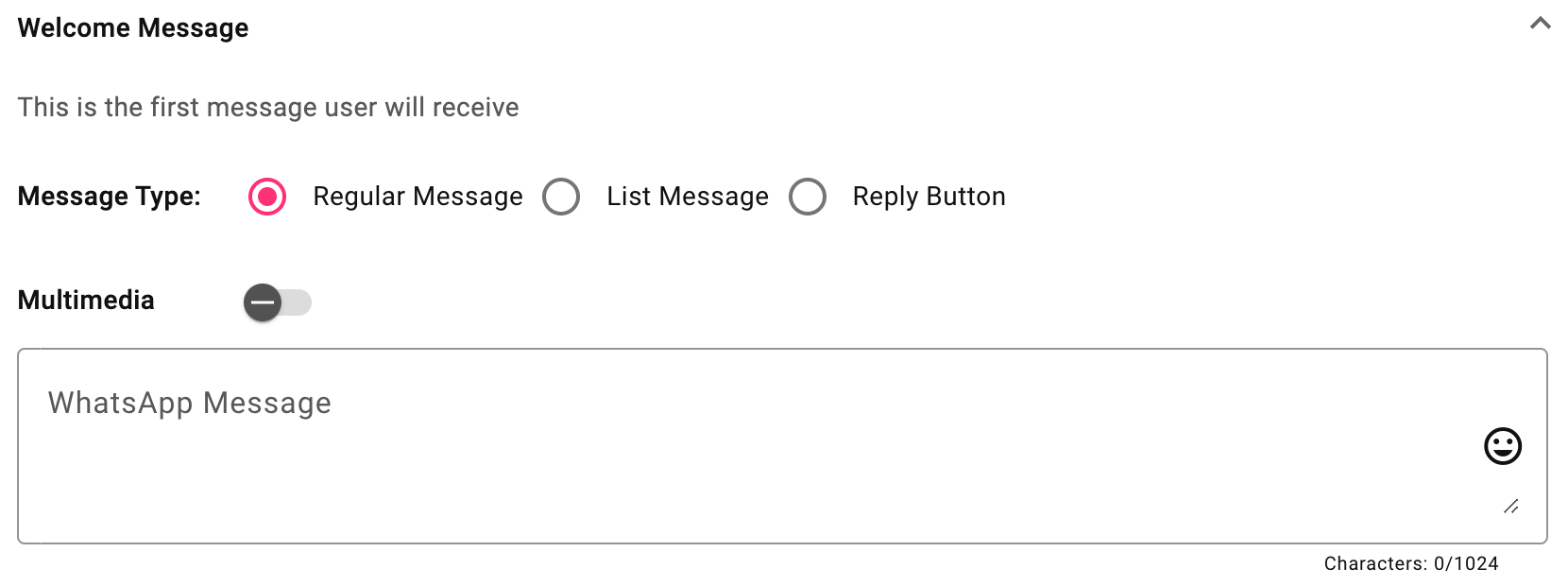
For WhatsApp, to include multimedia files in your message, switch on the toggle. After enabling it, you can upload files by dragging and dropping them into the designated box.
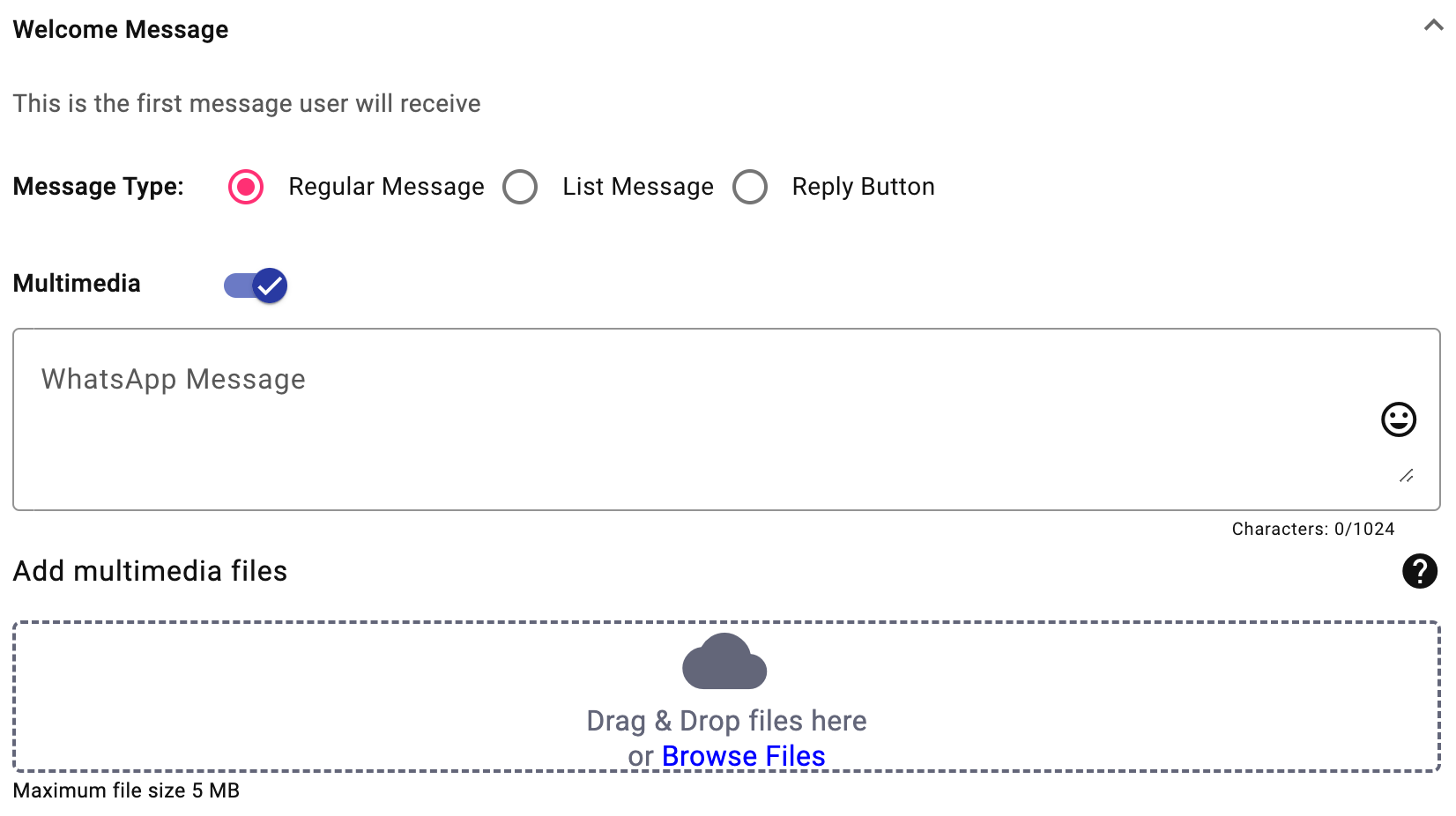
You can attach up to four types of multimedia files to a message on WhatsApp, each with a maximum size of 5 MB:
The file will be sent as a separate message, either before or after the chatbot interaction message, as delivery order is not guaranteed.
| Media File Type | Format | Size |
|---|---|---|
| Audio | .aac, .amr, .ogg; codec = opus | 5 MB |
| Document | 5 MB | |
| Video | .mp4 or .3gpp (H.264 video and aac audio codecs) | 5 MB |
| Image | .jpg, .png | 5 MB |
Setting Pre-fix Menu
In this section, we are going to set the available options that users can pick from.

The first step is to configure the selection menu through the Menu Pre-fix option.
A Menu Pre-fix scheme with an option for numbers or letters through radio buttons. Each prefix adds 4 characters to the message length which is a consideration for the SMS case, given its 160 maximum character length. These single-character keyword prefixes will be what the end user texts back as a response to each step in the chatbot flow. Each number or letter represents a response to the particular interaction that the user finds herself/himself in.

The next step is to specify where the user will be redirected once they select the desired option from the menu. Additionally, the user responses in the form of a single character allow the chatbot to redirect the user to the next action.

For SMS, you can include from 1 to 4 response options.
For WhatsApp and RCS, you can include from 1 to 20 response options
Each configured Response Option will be displayed in the table.
The Response Option is segmented into three boxes: Menu Text, Redirect Type, and Redirect To.
Menu Text
The Menu text box is where you enter the names of the options that the user will choose from. For consideration in the SMS case, is the length of the name since it will be added to the overall character count of the message. WhatsApp affords much more leeway given that it does not have this type of restriction and it also includes emoji capability.

Redirect Type
The Redirect type specifies the next step in the chatbot's sequence. The platform provides five options to choose from.
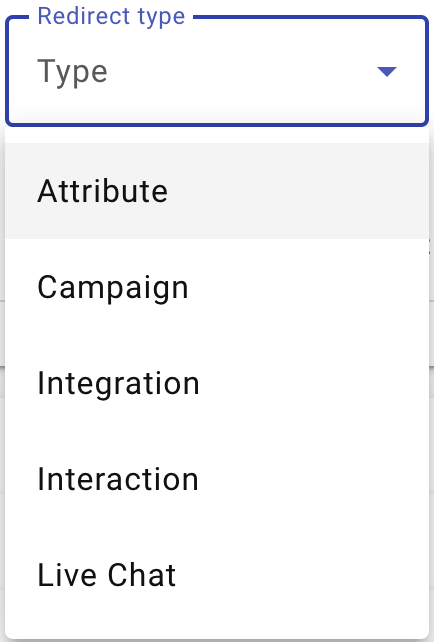
-
Attribute: Attributes act as placeholders, also known as personalized fields, that enable the chatbot to request and capture specific information from the end user. These attributes can be customized to store details such as the user’s name, email, address, or any other relevant information, enhancing the chatbot’s ability to provide a personalized experience. To learn how to configure attributes go to the Attributes section
-
Campaign: defines if the next item in the flow corresponds to a Live platform campaign with content associated with the chatbot’s intended purpose, an out-of-flow action.
-
Integration: defines if the next item in the flow corresponds to a third-party solution that can be added to the interaction flow with your customers using the chatbot as the communication vehicle.
There are three types of integrations: Bright Pattern, OpenAI, and Custom Webhook.
By selecting the Integration as Redirect Type, an interaction timeout will be displayed.
This interaction timeout will help you to close the interaction (communication) between the end user and the chatbot. That is, sets the total number of minutes that must elapse due to inactivity. For example, if a session has started but the end-user hasn't responded to or interacted with the campaign, the session will end after a certain amount of time has elapsed.
 NOTE
NOTEThe max time the session can wait before closing is 120 minutes.
-
Interaction: defines if the next item in the flow corresponds to another interaction step within the chatbot flow, an in-flow interaction.
-
Live Chat: Specifies whether the subsequent element in the workflow links to an agent from the Live Chat feature.
To redirect the end user to the agent, click on the Live Chat option located in the Redirect Type dropdown. Then, set the total minutes that must elapse due to inactivity. For example, if the end user selects the links to the agent but the end user doesn't respond to the agent within 5 minutes, the connection will be finished.

To create, build, and deploy a chatbot that connects to the Live Chat feature, go to the Integrate Chatbot with Live Chat section.
-
Webhook: defines a notification event to be sent and handled by your application, passing on the data that identifies the step in the flow to which webhook corresponds to the user has arrived, another out-of-flow action.
To learn about setting up a webhook through a Chatbot, refer to the Setting Webhook section.
Redirect To
The Redirect To represents the identity of the destination to which the platform will go for its next action. It is the identity of an interaction, a platform-defined campaign, or a webhook event notification, according to the redirect type chosen.

When Campaign is chosen as the Redirect Type, the Redirect To dropdown will list all Live status campaigns available with the next format: Campaign Name_Campaign Type.
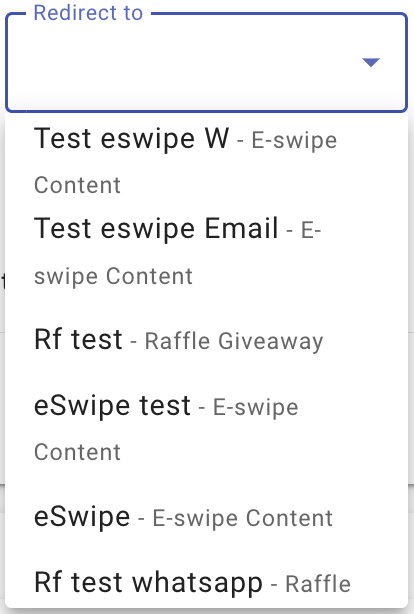
When Integration is chosen as the Redirect Type, the Redirect To dropdown will list all integrations created and available with the next format: Alias_Integration Type.
Actually, we support the Bright Pattern, OpenAI, and Custom Webhook Integrations.
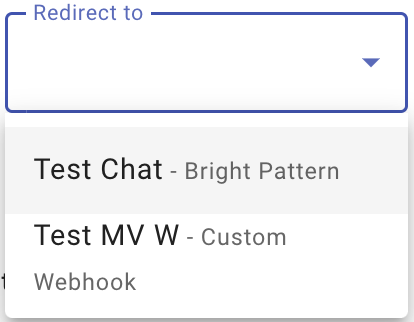
For more information, to create and enable each integration, go to the Integrations section.
When Interaction is chosen as the Redirect Type, the Redirect To dropdown will list all interactions created when setting the chatbot.
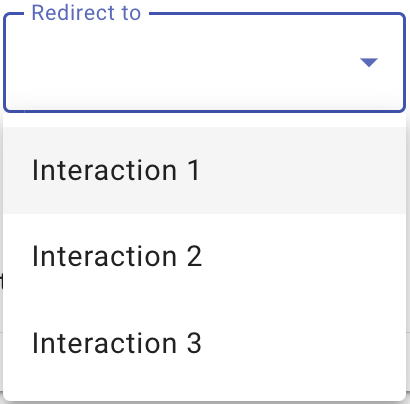
When Live Chat is chosen as the Redirect Type, the Redirect To dropdown will list all the teams available in the Live Chat platform.

Therefore, when Live Chat is selected as the Redirect Type, the Redirect To dropdown lets you choose which team will receive the conversation. The options shown are based on the teams configured in your Live Chat platform.
- Specific Team (e.g., Product, Sales, Support Team): Routes all incoming conversations from the chatbot to the selected team.
- Default assignment: Uses the default team routing defined in your Live Chat platform’s settings.
This setting ensures conversations are directed to the right team based on the chatbot’s purpose.
Once the Redirect type and the Redirect To are configured by selecting the Add button, you have the option to add a webhook.
For more information on incorporating a webhook into your chatbot, please refer to the Setting Webhook section.
Therefore, once the "redirect type" and "redirect to" configuration is complete, each item will be included in a menu item table displayed under the configuration section. Menu items will be placed in ascending order as they are entered, automatically advancing the keyword identifier at each menu entry.
The following screenshot shows a populated WhatsApp chatbot Welcome Message sample with possible options that can be configured into any given chatbot step in its flow with the table at the bottom.
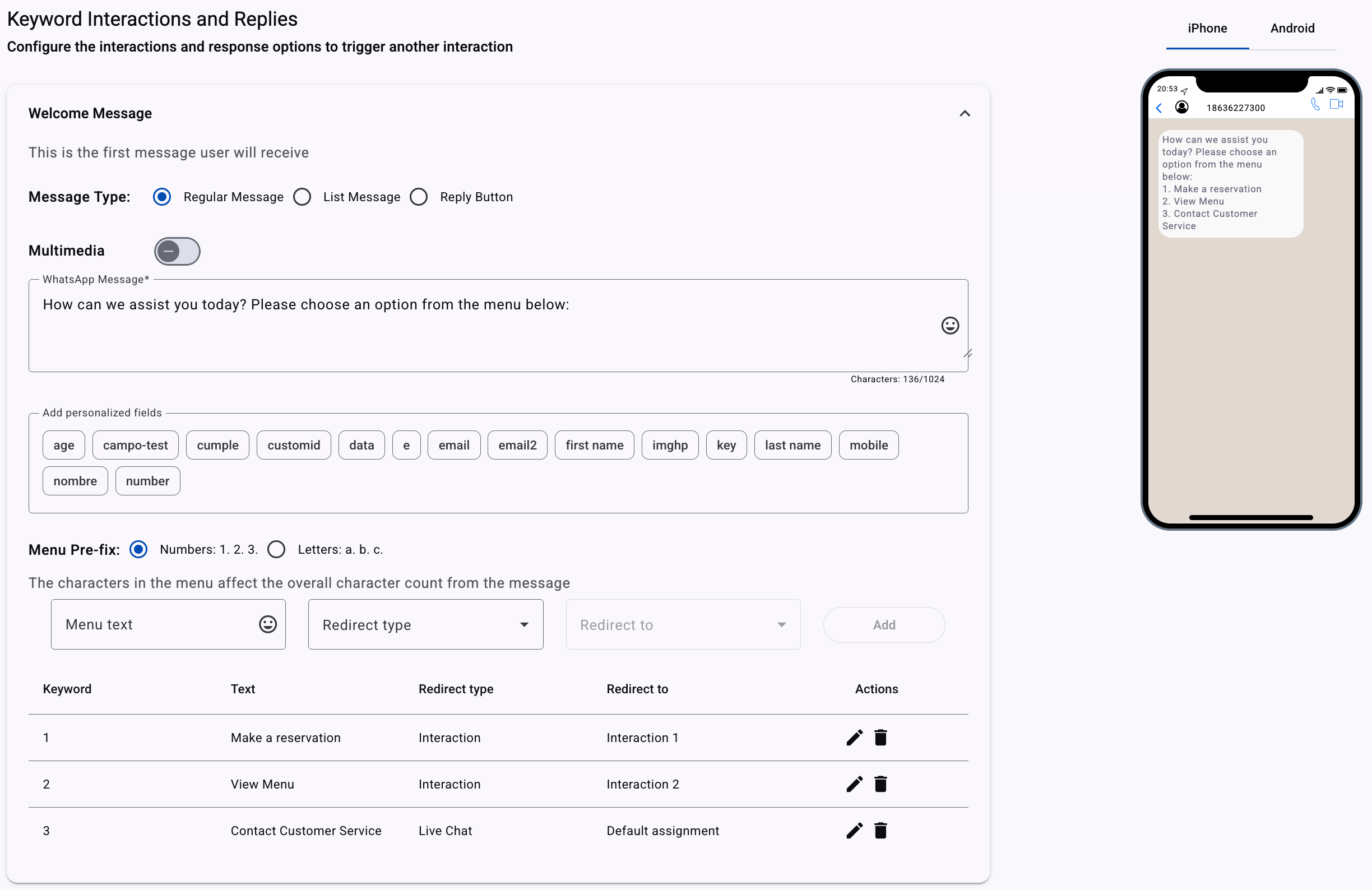
After configuring the Welcome Message, the next step is to define the Interaction flow.
Interaction
In the Interaction section, you define how the chatbot engages with users by creating automated responses, questions, and actions based on user inputs or triggers. This shapes the conversational flow, ensuring dynamic and personalized interactions that effectively guide users and provide information.
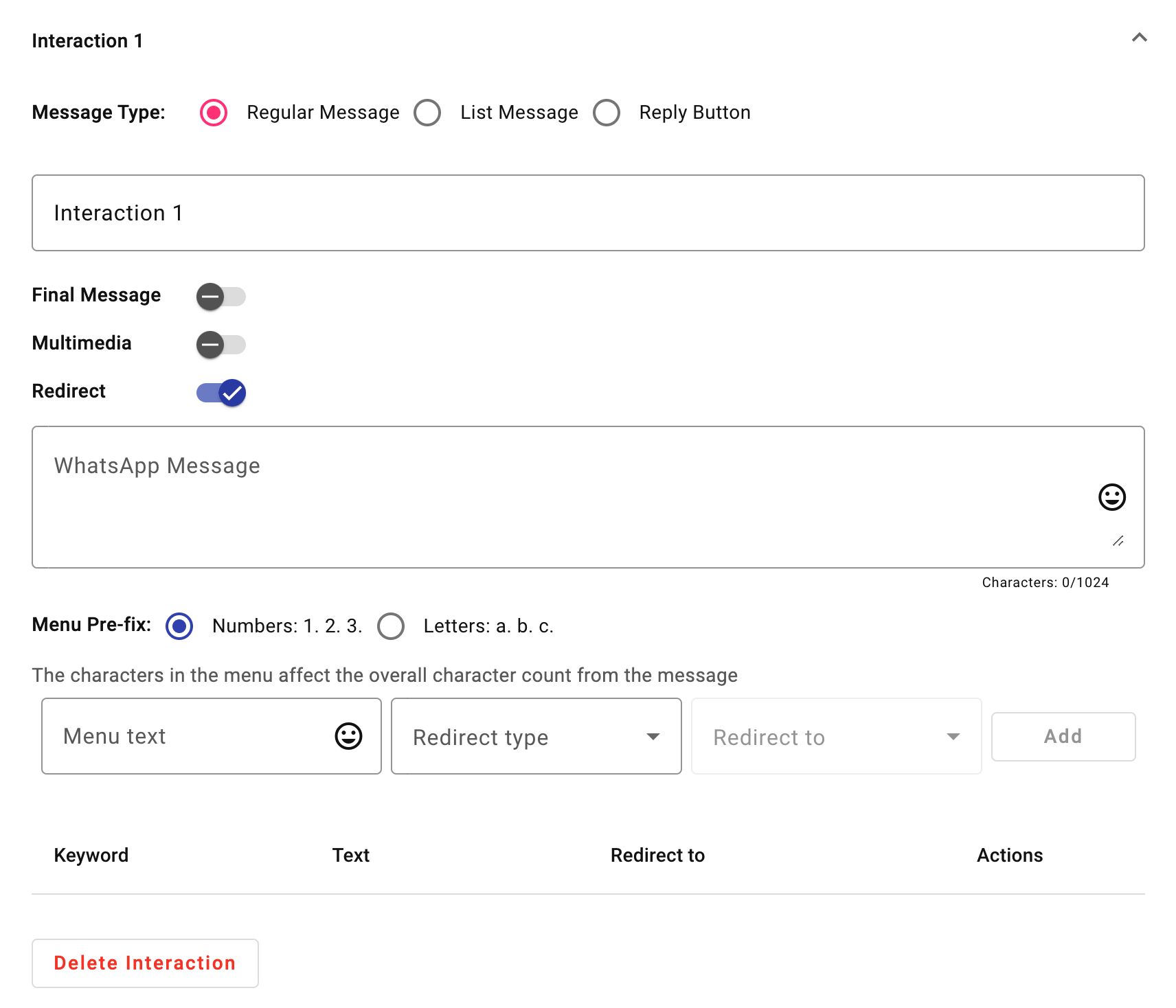
To know the steps for setting up each Interaction, go to the Interaction section.
Updated 3 months ago
